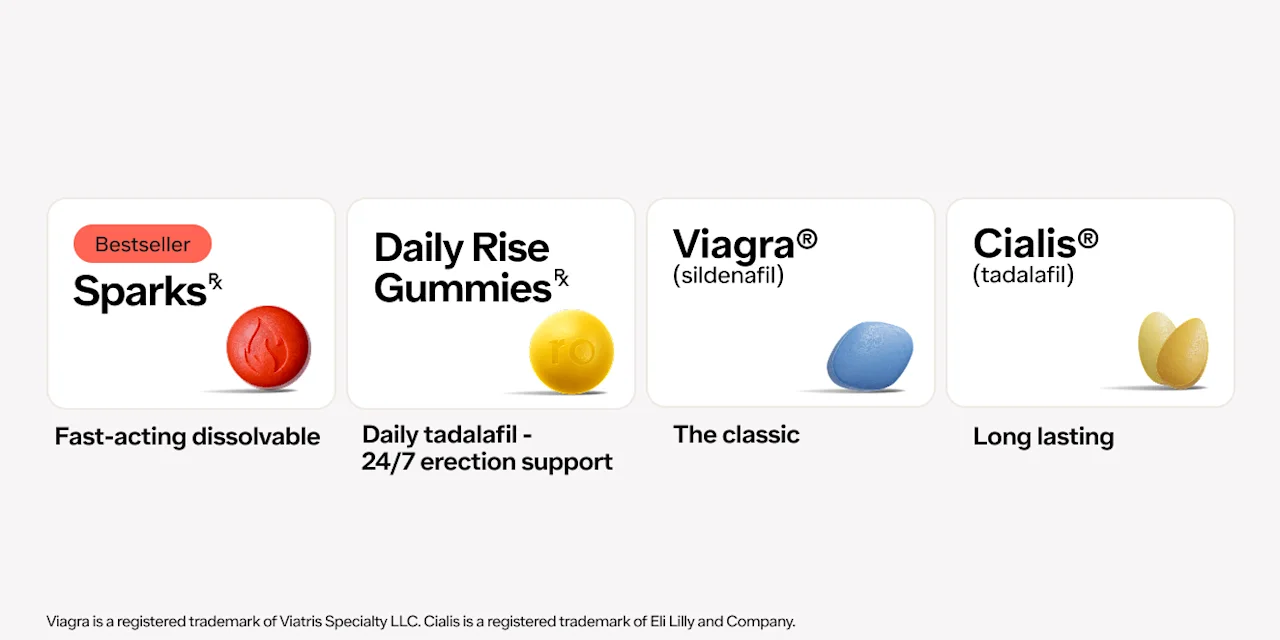Key takeaways
PDE5 inhibitors are a class of medications that work in part by increasing blood flow to certain areas of the body, including the penis.
Common PDE5 inhibitors include Viagra (sildenafil), Cialis (tadalafil), vardenafil, and Stendra (avanafil).
In addition to treating ED, PDE5 inhibitors can also be used for conditions such as pulmonary hypertension and urinary symptoms, including those from an enlarged prostate.
Here's what we'll cover
Here's what we'll cover
Here's what we'll cover
Key takeaways
PDE5 inhibitors are a class of medications that work in part by increasing blood flow to certain areas of the body, including the penis.
Common PDE5 inhibitors include Viagra (sildenafil), Cialis (tadalafil), vardenafil, and Stendra (avanafil).
In addition to treating ED, PDE5 inhibitors can also be used for conditions such as pulmonary hypertension and urinary symptoms, including those from an enlarged prostate.
Curious about medications for erectile dysfunction (ED)? Then let’s discuss phosphodiesterase type 5 inhibitors, or PDE5 inhibitors, a class of medications proven to be safe and effective at treating ED. So much so, in fact, that they’re often used as first-line treatment for the condition. Viagra (sildenafil) is arguably the most well-known example, but the little blue pill is just one of the handful of commonly prescribed PDE5 inhibitors out there.
So, we broke down their distinguishing characteristics—from how long they last to how much they cost—to create the below PDE5 primer. Continue reading to learn more about PDE5 inhibitors, starting with what they are and how they work to treat ED and conditions.
What are PDE5 inhibitors and how do they work?
PDE5 inhibitors are a group of medications that work in part by relaxing blood vessels and increasing blood flow to certain areas of the body. They do this by blocking or slowing the activity of an enzyme called phosphodiesterase type 5 (PDE5). (Thus, the drug class’ name.)
Viagra (sildenafil) was the first PDE5 inhibitor approved by the Food and Drug Administration (FDA) to treat ED in the 1990s. Its popularity for ED spurred more research into other potential uses of this drug class, ultimately leading to applications in treating pulmonary hypertension and managing urinary symptoms in men with benign prostatic hyperplasia.
Let’s take a closer look at how PDE5 inhibitors work for these conditions, starting with their most common use: ED.
How do PDE5 inhibitors work for ED?
First, it helps to understand the basics of ED and erections. ED, sometimes called impotence, is the inability to get or keep an erection long enough for satisfying sex. While it can happen for a wide range of reasons, ED is often caused by physical changes that lead to poor blood flow because of partially blocked blood vessels (e.g., from cardiovascular disease) or inadequate nerve stimulation of blood flow (e.g. diabetes, surgery/other damage to nerves including those near the prostate gland, often from prostate cancer treatment).
Now, erection 101: When aroused, your brain sends signals to the nerves in your penis. This triggers the production of cGMP, a chemical that causes the muscles in your penis to relax and widen, which allows more blood to flow into your member. Meanwhile, the veins that drain blood from the penis contract, limiting blood from leaving the penis and trapping it so you get hard. An erection ends when the PDE5 enzyme breaks down cGMP, causing blood to flow back out of the penis. Problems with any part of this process can contribute to a problem obtaining or maintaining an erection (sexual dysfunction).
To treat ED, PDE5 inhibitors block the PDE5 enzyme, which prevents the breakdown of cGMP. As a result, the penile blood vessels become more relaxed and dilated, which helps increase blood flow to the penis and leads to harder, longer-lasting erections. Keep in mind that taking a PDE5 medication doesn’t mean you’ll automatically get hard; you still need sexual stimulation to start the process.
The most common PDE5 inhibitors for ED include:
Viagra (sildenafil)
Vardenafil (formerly available as brand name Levitra)
Stendra (avanafil)
How do PDE5 inhibitors work for other conditions?
PDE5 inhibitors are also useful for managing lower urinary tract symptoms in men with benign prostatic hyperplasia (BPH)—aka enlarged prostate. When the prostate becomes enlarged, it squeezes the urethra and can cause problems with urination, such as a weak urine stream. By increasing blood flow to the bladder, PDE5 inhibitors can lessen irritability of the bladder and improve urinary symptoms. PDE5 inhibitors often can serve double-duty for men with both ED and BPH; the conditions can occur together and other meds to treat BPH, such as finasteride (Proscar) or tamsulosin (Flomax), can cause or worsen ED.
Sometimes, PDE5 inhibitors are prescribed off-label to treat premature ejaculation in men with ED and to help maintain blood flow to the penis while penile nerve tissue recovers its ability to support erections after prostate removal surgery, among other uses.
PDE5 inhibitors can also be a useful treatment for pulmonary arterial hypertension (PAH), a condition characterized by high blood pressure in the arteries in the lungs. PAH can cause shortness of breath and a diminished ability to be physically active—two symptoms that can be eased by PDE5 inhibitors. That’s because the medications relax blood vessels in the lungs and lower blood pressure in those vessels, which can make it easier for your heart to pump blood to your lungs.
Side effects of PDE5 inhibitors
Because PDE5 inhibitors have similar mechanisms of action, they all share several common side effects, including:
Headache
Flushing (more common with sildenafil)
Dyspepsia (i.e. heartburn)
Back and muscle pain (more common with tadalafil)
Dizziness
Runny or congested nose
While uncommon, some people have reported serious side effects with PDE5 inhibitors, such as priapism (an erection that lasts more than 4 hours). In this instance, it’s important to seek immediate medical attention.
These medications may not be safe for those who take medications that also relax blood vessels, such as nitrates, drugs including nitroglycerin, that may be used for men who have heart-related chest pain, had a recent heart attack, stroke, or other cardiovascular problems. By widening blood vessels, PDE5 inhibitors can cause a temporary drop in blood pressure, which could interact with medications such as nitrates that are commonly used for these conditions.
Before starting any medication, including a PDE5 inhibitor, it’s important to talk to your healthcare provider and share your medical history, whether you’re taking any other Rx meds or supplements. This information can help an expert best determine a treatment plan that’ll reduce the risk of potential side effects and negative drug interactions. You should also make sure you are cleared for sexual activity by your healthcare provider before using PDE5 inhibitors for this purpose.
Types of PDE5 inhibitors
Viagra (sildenafil)
The first FDA-approved PDE5 inhibitor for ED, Viagra (sildenafil) comes as an oral tablet in 25 mg, 50 mg, and 100 mg. To treat ED, the recommended timing is 1 hour before sexual activity, but you can take it as little as 30 minutes or as long as 4 hours beforehand. The maximum recommended daily dose of Viagra is 100 mg. Absorption of sildenafil is very dependent on the amount of food in the stomach, especially fatty food. Sildenafil is best absorbed on an empty stomach; before eating a meal or at least 3 hours after eating.
Viagra’s active ingredient is sildenafil, which is also available as a generic drug that retails for around $320 for ten 50-mg tablets. In comparison, the same quantity and strength of the brand-name version, Viagra, retails for close to $950. Keep in mind that these prices—as well as any medication costs —can vary depending on several factors, insurance coverage (if any), location, discounts, and more.
Sildenafil is also the active ingredient in two medications that are FDA-approved to treat PAH: Revatio and Liqrev—both of which are available as an oral liquid suspension that contains 10 mg per mL. Revatio also comes as a 20-mg oral tablet. When used for treating pulmonary hypertension, these preparations are typically taken three times per day.
Cialis (tadalafil)
Cialis (tadalafil) was FDA approved in 2003. It’s an oral tablet available in several strengths ranging from 2.5 mg to 20 mg. Often called the “weekend pill,” tadalafil can improve erectile function for up to 36 hours after you take a dose. Cialis has two different dosing options for treating ED: as-needed before sex (like Viagra) or once daily. The once-daily option offers the advantage of maintaining a level of the medication in your body, so that you can be ready for sex whenever the mood strikes, without having to wait for the pill to kick in. Cialis is also FDA-approved to manage the symptoms of BPH in men with or without ED.
Tadalafil, the active ingredient in Cialis, costs around $301 for thirty 5-mg tablets (a one-month supply if you take it daily). It’s around $100 for 10 tablets.
Tadalafil is also the active ingredient in the following brand-name medications:
Chewtadzy, a new chewable tablet used to treat ED, BPH, or both
Tadliq, an oral suspension used for PAH
Adcirca, a 40-mg oral tablet used for PAH
It can also be found in other formulations, such as Ro’s Daily Rise Gummies and Ro Sparks.
Each of the fruit-flavored gummies features 7 mg of tadalafil and is designed to be taken once a day so you’re ready for a romp whenever. You can also find tadalafil combined with sildenafil (reminder: active ingredient in Viagra) in Ro Sparks, a long-lasting sublingual ED treatment that dissolves under your tongue to reach your bloodstream (and get to work) faster. Sometimes using two drugs in the same class can greatly increase efficacy without a significant risk of side effects.
Vardenafil
Vardenafil has been available since 2003. Its two forms are an oral tablet that dissolves on your tongue and an oral tablet that you swallow. The former comes in 10 mg while the latter is available in several strengths: 2.5 mg, 5 mg, 10 mg, and 20 mg.
The recommended dose timing of vardenafil is 1 hour before sexual activity, but it can start to kick in as soon as 10 minutes post-ingestion for some men. Vardenafil’s effects typically start to wear off after 5 hours.
Vardenafil was previously sold under the brand names Levitra and Staxyn, but they have been discontinued. Now, it’s only available as generic medication. The average retail price of vardenafil 20 mg is around $500 for 10 tablets.
Stendra (avanafil)
The FDA approved Stendra (avanafil) in 2012 to treat ED. It’s an oral tablet that’s available in varying strengths—50 mg, 100 mg, and 200 mg—and starts working quickly. You take it approximately 15–30 minutes before sexual activity. Some men with ED have reported successful sex attempts less than 15 minutes after taking a dose of this PDE5 inhibitor. And some have reported success more than 6 hours post-dose.
As the newest brand-name PDE5 inhibitor on the market, Stendra has a retail cost of around $793 for ten 200-mg tablets. Its active ingredient is avanafil but there isn’t a generic out yet.
Comparing PDE5 inhibitors for ED
The table below compares key information about popular PDE5 inhibitor medications for ED.
| Viagra (sildenafil) | Cialis (tadalafil) | Vardenafil | Stendra (avanafil) |
Forms and strengths in milligrams (mg) | Oral tablet: 25 mg, 50 mg, 100 mg (the generic also comes in 20 mg) | Oral tablet: 2.5 mg, 5 mg, 10 mg, 20 mg | Orally disintegrating tablet: 10 mg; Oral tablet: 2.5 mg, 5 mg, 10 mg, 20 mg | Oral tablet: 50 mg, 100 mg, 200 mg |
Recommended time to take it for ED | Take 1 hour before sexual activity | Take once daily or 30 to 60 minutes before sexual activity | Take 1 hour before sexual activity | Take 15 to 30 minutes before sexual activity |
How soon it starts working for ED | 30 minutes to 2 hours | 30 minutes to 2 hours | 30 minutes | 15 to 30 minutes |
How long it lasts for ED | ~4 hours | ~36 hours | ~5 hours | ~6 hours |
Generic available? | Yes | Yes | Yes | No |
Other PDE5 inhibitors
Certain herbs naturally contain compounds that can act as mild PDE5 inhibitors, and some people take them as supplements. Such supplements are often sold in health food stores and online, but they aren’t FDA-approved. The FDA doesn't regulate dietary supplements. So, their effectiveness and safety are not guaranteed.
The FDA also warns consumers about sexual or male enhancement products that may have hidden ingredients and pose serious risks. Be sure to consult with a healthcare provider before trying a dietary supplement, especially ones claiming to improve erections.
While not a comprehensive list, the following herbs and natural substances are thought to have potential benefits for ED thanks to their potential ability to act like PDE5 inhibitors.
Tribulus terrestris
One small study in men with mild-to-moderate ED showed that extracts from the plant Tribulus terrestris significantly improved sexual function, including erections, sexual desire, and overall satisfaction compared to a placebo.
Thai ginseng
Kaempferia parviflora, also known as Krachai dum, black ginger, or Thai ginseng, shows some ability to inhibit the PDE5 enzyme. In one very small study, 14 people who used this supplement reported improved erections and were more sexually satisfied. But the study had limitations, such as not having a comparison group, so we don’t know if we can rely on the findings.
L-arginine
Some research shows that taking L-arginine with PDE5 inhibitors can improve erectile function more than using either treatment alone. But the combination could also raise the risk of side effects, such as dizziness, so you shouldn’t add an L-arginine supplement unless you first check with your healthcare provider. Like PDE5 drugs, L-arginine isn’t recommended for people who’ve recently had a heart attack.
Horny goat weed
Limited evidence suggests that the icariin component of horny goat weed may help improve erectile dysfunction. Animal studies suggest that icariin can increase blood flow to the penis in rats, but its effect in humans isn’t clear.
Bottom line on PDE5 inhibitors
PDE5 inhibitors—e.g. sildenafil (Viagra), tadalafil (Cialis), vardenafil, and avanafil (Stendra)— can be safe and effective treatment options for ED. They work by blocking the PDE5 enzyme to widen blood vessels, allowing more blood to flow to the penis. Besides ED, some PDE5 inhibitors have also been FDA-approved to treat conditions, such as PAH and BPH.
Meanwhile, certain herbs and supplements, such as Tribulus terrestris and L-arginine, may have mild PDE5-inhibiting effects. While they’re commonly marketed as natural alternatives for improving erectile function, research is quite limited, so we don’t know enough about their safety and efficacy in humans. Plus, dietary supplements aren’t regulated by the FDA.
At the end of the day, it’s important to consult with a healthcare provider if you’re dealing with ED and interested in potentially trying PDE5 inhibitors; they can help determine treatment options that are right for you.
DISCLAIMER
If you have any medical questions or concerns, please talk to your healthcare provider. The articles on Health Guide are underpinned by peer-reviewed research and information drawn from medical societies and governmental agencies. However, they are not a substitute for professional medical advice, diagnosis, or treatment.
Viagra Important Safety Information: Read more about serious warnings and safety info.
Cialis Important Safety Information: Read more about serious warnings and safety info.
Finasteride Important Safety Information: Read more about serious warnings and safety info.
References
Andersson, K. E. (2018). PDE5 inhibitors - pharmacology and clinical applications 20 years after sildenafil discovery. British Journal of Pharmacology, 175(13), 2554–2565. doi: 10.1111/bph.14205. Retrieved from https://www.ncbi.nlm.nih.gov/pmc/articles/PMC6003652/
Barnes, H., Brown, Z., Burns, A., et al. (2019). Phosphodiesterase 5 inhibitors for pulmonary hypertension. The Cochrane Database of Systematic Reviews, 1(1), CD012621. doi: 10.1002/14651858.CD012621.pub2. Retrieved from https://www.ncbi.nlm.nih.gov/pmc/articles/PMC6354064/
ClinCalc. (2021). Phosphodiesterase 5 Inhibitor Established Pharmacologic Class (EPC) Comparison, United States, 2021. Retrieved from https://clincalc.com/DrugStats/EPC/Phosphodiesterase5Inhibitor
DailyMed-a. (2023). Vardenafil - vardenafil hydrochloride tablet, film coated. Retrieved on Jul. 23, 2024 from https://dailymed.nlm.nih.gov/dailymed/fda/fdaDrugXsl.cfm?setid=d2dce236-257e-44b6-93a9-9f0280257c6a&type=display
DailyMed-b. (2023). Vardenafil - vardenafil tablet, orally disintegrating. Retrieved on Jul. 13, 2024 from https://dailymed.nlm.nih.gov/dailymed/fda/fdaDrugXsl.cfm?setid=0ce4eb7b-fa50-441d-ae71-eb33dca27926&type=display
Dhaliwal A, & Gupta M. (2023). PDE5 Inhibitors. StatPearls. Retrieved on Jul. 13, 2024, from https://www.ncbi.nlm.nih.gov/books/NBK549843/
GoodRx-a. (2024). Avanafil. Retrieved on Jul. 13, 2024 from https://www.goodrx.com/avanafil
GoodRx-b. (2024). Sildenafil. Retrieved on Jul. 13, 2024 from https://www.goodrx.com/sildenafil
GoodRx-c. (2024). Tadalafil. Retrieved on Jul. 13, 2024 from https://www.goodrx.com/cialis
GoodRx-d. (2024). Vardenafil. Retrieved on Jul. 13, 2024 from https://www.goodrx.com/vardenafil
GoodRx-e. (2024). Viagra. Retrieved on Jul. 23, 2024 from https://www.goodrx.com/viagra?form=tablet&dosage=50mg&quantity=10&label_override=viagra&slug=viagra
Kamenov, Z., Fileva, S., Kalinov, K., et al. (2017). Evaluation of the efficacy and safety of Tribulus terrestris in male sexual dysfunction-A prospective, randomized, double-blind, placebo-controlled clinical trial. Maturitas, 99, 20–26. doi: 10.1016/j.maturitas.2017.01.011. Retrieved from https://pubmed.ncbi.nlm.nih.gov/28364864/
Kaplan-Marans, E., Sandozi, A., Martinez, M., et al. (2022). Medications Most Commonly Associated With Erectile Dysfunction: Evaluation of the Food and Drug Administration National Pharmacovigilance Database. Sexual Medicine, 10(5), 100543. doi: 10.1016/j.esxm.2022.100543. Retrieved from https://www.ncbi.nlm.nih.gov/pmc/articles/PMC9537247/
Krzastek, S. C., Bopp, J., Smith, R. P., & Kovac, J. R. (2019). Recent advances in the understanding and management of erectile dysfunction. F1000Research, 8, F1000 Faculty Rev-102. doi: 10.12688/f1000research.16576.1. Retrieved from https://www.ncbi.nlm.nih.gov/pmc/articles/PMC6348436/
Leslie, S. W. & Sooriyamoorthy, T. (2024). Erectile dysfunction. StatPearls. Retrieved on Jul. 13, 2024 on https://www.ncbi.nlm.nih.gov/books/NBK562253/
Montorsi, F., Padma-Nathan, H., Buvat, J., et al. (2004). Earliest time to onset of action leading to successful intercourse with vardenafil determined in an at-home setting: a randomized, double-blind, placebo-controlled trial. The Journal of Sexual Medicine, 1(2), 168–178. doi: 10.1111/j.1743-6109.2004.04025.x. Retrieved from https://pubmed.ncbi.nlm.nih.gov/16422971/
Schulman, S. P., Becker, L. C., Kass, D. A., et al. (2006). L-arginine therapy in acute myocardial infarction: the Vascular Interaction With Age in Myocardial Infarction (VINTAGE MI) randomized clinical trial. JAMA, 295(1), 58–64. doi: 10.1001/jama.295.1.58. Retrieved from https://jamanetwork.com/journals/jama/fullarticle/202136
Stein, R. A., Schmid, K., Bolivar, J., et al. (2018). Kaempferia parviflora ethanol extract improves self-assessed sexual health in men: a pilot study. Journal of Integrative Medicine, 16(4), 249–254. doi: 10.1016/j.joim.2018.05.005. Retrieved from https://www.sciencedirect.com/science/article/abs/pii/S2095496418300633
U.S. Food and Drug Administration (FDA-a). (2018). Chewtadzy (tadalafil) chewable tablets, for oral use. Retrieved on Jul. 13, 2024 from https://www.accessdata.fda.gov/drugsatfda_docs/label/2024/218527s000lbl.pdf
U.S. Food and Drug Administration (FDA-b). (2018). Cialis (tadalafil) tablets, for oral use. Retrieved on Jul. 13, 2024 from https://www.accessdata.fda.gov/drugsatfda_docs/label/2018/021368s030lbl.pdf
U.S. Food and Drug Administration (FDA-a). (2023). Liqrev (sildenafil) oral suspension. Retrieved Jul. 23, 2024 from https://www.accessdata.fda.gov/drugsatfda_docs/label/2023/214952s000lbl.pdf
U.S. Food and Drug Administration (FDA). (n.d.). Orange Book: Approved Drug Products with Therapeutic Equivalence Evaluations. Retrieved Jul. 23, 2024 from https://www.accessdata.fda.gov/scripts/cder/ob/index.cfm
U.S. Food and Drug Administration (FDA-b). (2023). Revatio (sildenafil) tablets, for oral use; Revatio (sildenafil) for oral suspension; Revatio (sildenafil) injection, for intravenous use. Retrieved on Jul. 23, 2024 from https://www.accessdata.fda.gov/drugsatfda_docs/label/2023/021845s025lbl.pdf
U.S. Food and Drug Administration (FDA-a). (2022). Stendra (avanafil) tablets, for oral use. Retrieved on Jul. 13, 2024 from https://www.accessdata.fda.gov/drugsatfda_docs/label/2022/202276s020lbl.pdf
U.S. Food and Drug Administration (FDA-b). (2022). Tadliq (tadalafil) oral suspension. Retrieved on Jul. 13, 2024 from https://www.accessdata.fda.gov/drugsatfda_docs/label/2022/214522s000lbl.pdf
U.S. Food and Drug Administration (FDA). (2024). Tainted Sexual Enhancement and Energy Products. Retrieved Jul. 14, 2024 from https://www.fda.gov/drugs/medication-health-fraud/tainted-sexual-enhancement-and-energy-products
U.S. Food and Drug Administration (FDA). (2017). Viagra (sildenafil citrate) tablets, for oral use. Retrieved on Jul. 13, 2024 from https://www.accessdata.fda.gov/drugsatfda_docs/label/2017/020895s048lbl.pdf
Wang, C. (2010). Phosphodiesterase-5 inhibitors and benign prostatic hyperplasia. Current Opinion in Urology, 20(1), 49–54. doi: 10.1097/MOU.0b013e328333ac68. Retrieved from https://journals.lww.com/co-urology/abstract/2010/01000/phosphodiesterase_5_inhibitors_and_benign.9.aspx
Xu, D., Zhang, Y., Bai, J., et al. (2023). Botanical drugs for treating erectile dysfunction: clinical evidence. Frontiers in Pharmacology, 14, 1232774. doi: 10.3389/fphar.2023.1232774. Retrieved from https://www.ncbi.nlm.nih.gov/pmc/articles/PMC10467024/
Xu, Y., Xin, H., Wu, Y., et al. (2017). Effect of icariin in combination with daily sildenafil on penile atrophy and erectile dysfunction in a rat model of bilateral cavernous nerves injury. Andrology, 5(3), 598-605. doi: 10.1111/andr.12341. Retrieved from https://onlinelibrary.wiley.com/doi/10.1111/andr.12341
Xu, Z., Liu, C., Liu, S., et al. (2021). Comparison of efficacy and safety of daily oral L-arginine and PDE5Is alone or combination in treating erectile dysfunction: A systematic review and meta-analysis of randomised controlled trials. Andrologia, 53(4), e14007. doi: 10.1111/and.14007. Retrieved from https://pubmed.ncbi.nlm.nih.gov/33587304/












